Trees Birds Mammals Fish Amphibians Reptiles
Wild Algarve
Bookshop
Gymnopus fusipes (Bull.) Gray - Spindleshank
Phylum: Basidiomycota - Class: Agaricomycetes - Order: Agaricales - Family: Marasmiaceae
Distribution - Taxonomic History - Etymology - Identification - Culinary Notes - Reference Sources
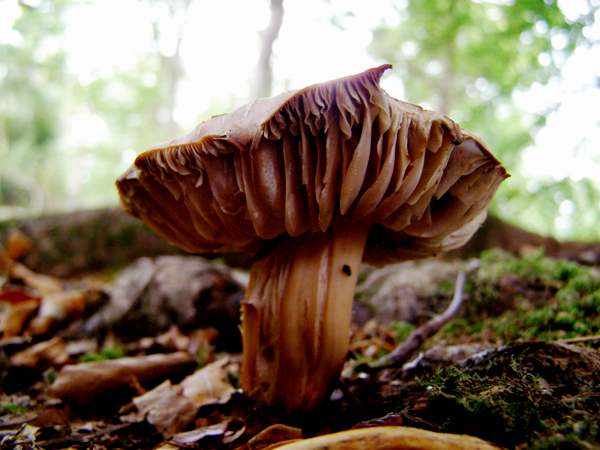
The distinctive spindle-shaped stem of this mushroom is often buried and visible only after excavation. Spindleshank occurs in tufts nearly always on the basal roots of hardwood trees, notably Beech and oaks, although very occasionally this species is reported growing on the roots of conifers. Another helpful identification feature of Spindleshanks is their very wide gill spacing - far wider than other 'toughshanks'. (The tiny parasitic fungi on the gills pictured here are Spinellus fusiger.)
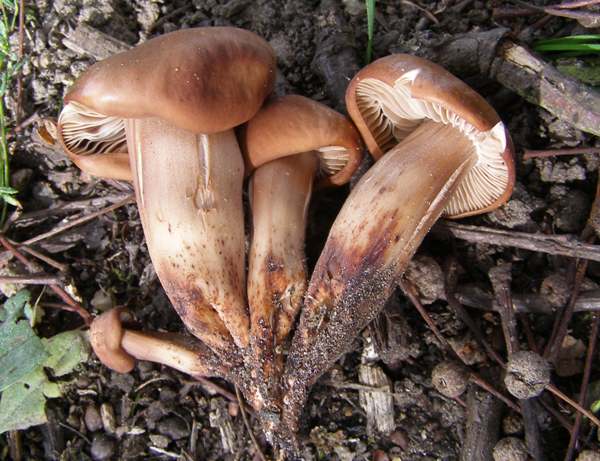
Gymnopus fusipes is the type species of the genus Gymnopus.
Infection by the mycelium, of this woodland mushroom is the cause of a root rot in oak trees, mainly Pedunculate Oak Quercus robur, and Northern Red Oak, Quercus rubra. Apart from seeing the fungal fruitbodies in autumn, evidence of the disease is often visible in the form of a deterioration of the crown of affected trees, although this is not always the case.
Fast-growing healthy trees seem able to cope better with attack by this fungus than slower-growing trees that are already struggling to survive.
Soil humidity seems to be a critical factor in the incidence of this type of root rot, as Gymnopus fusipes tends to show a marked preference for moderately dry to very dry or sandy soil rather than waterlogged soil.
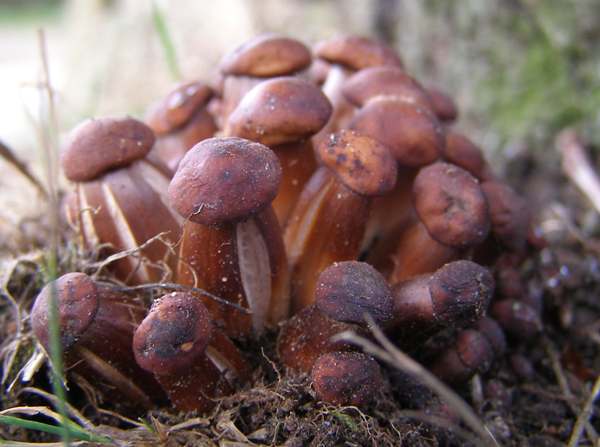
When young Spindleshanks mushrooms first appear at the base of a tree, they look like a fistful of fat copper nails. In the group shown above, seen in southern Portugal, dry weather has caused the tubby stems to split lengthways.
Distribution
Recurring on or beside the basal roots of oak trees and occasionally Beeches, Gymnopus fusipes occurs in woodland and parkland throughout Britain and Ireland; it is also found on the European mainland, where it is particularly common in warm dry central and southern countries, and in many parts of Asia. In the USA and Canada this fungus is considered an invasive species and a serious pest, as it does a great deal of damage to Quercus rubra, the Northern Red Oak, which is reported to be much more susceptible to Spindleshank root rot than the European oaks are.
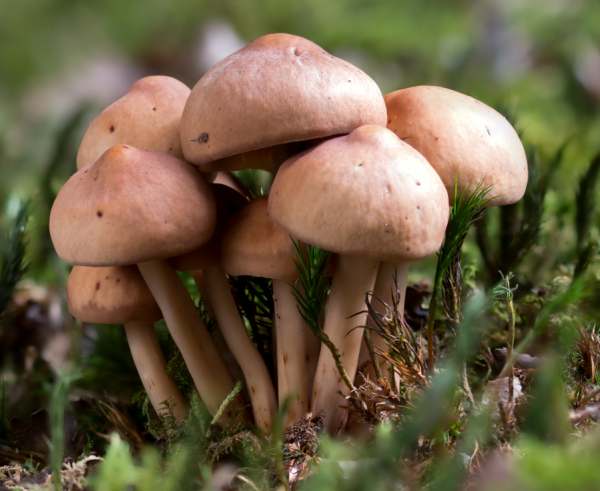
Taxonomic history
The basionym of this species dates from 1791, when French mycologist Jean Baptiste Francois (Pierre) Bulliard described Spindleshanks and gave them the scientific name Agaricus fusipes. (In those early days of fungus taxonomy, most of the gilled mushrooms were included initially in the genus Agaricus!) It was the British mycologist Samuel Frederick Gray (1766 - 1828) who in 1821 transferred this mushroom to the genus Gymnopus, thereby creating the binomial name Gymnopus fusipes by which Spindleshank is generally accepted today.
Until quite recently most field guides referred to Spindleshanks by the scientific name Collybia fusipes, a name given to this species by Lucien Quelet in 1872, and many authoritative online sources do not yet reflect the recent redistribution of many former Collybia species to other genera such as Gymnopus and Rhodocollybia.
Synonyms of Gymnopus fusipes include Agaricus crassipes Schaeff., Agaricus oedematopus Schaeff., Agaricus contortus Bull., Agaricus fusiformis Bull., Agaricus fusipes Bull., Collybia crassipes (Schaeff.) P. Kumm., Collybia fusipes (Bull.) Quél., Agaricus lancipes Fr., Collybia lancipes (Fr.) Gillet, Collybia oedematopoda (Schaeff.) Sacc.,and
Rhodocollybia fusipes (Bull.) Romagn.
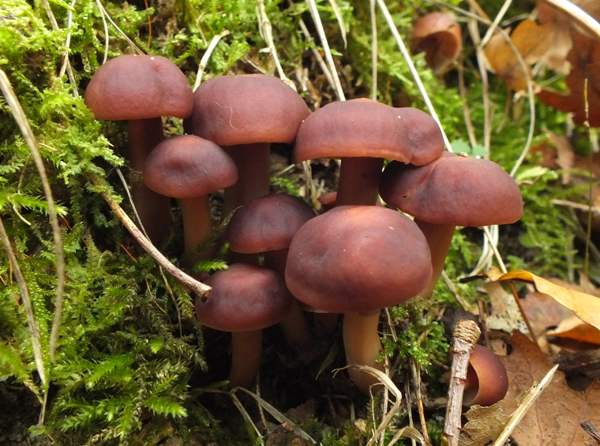
Etymology
Gymnopus, the generic name, comes from Gymn- meaning naked or bare, and -pus meaning foot (or, in the case of a mushroom, stem). The specific epithet fusipes means ' with spindle-shaped stems', and indeed most often the stems are centrally swollen and taper sharply towards the base - particularly so when, as is most often the case, these mushrooms occur in tufts rather than singly.
Identification guide
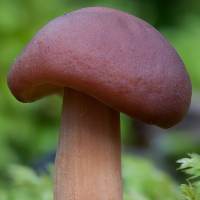 |
Cap
Convex, flattening with an irregular incurved margin at least until fully mature; 3 to 7cm across; brown, often with dark brown blotches. |
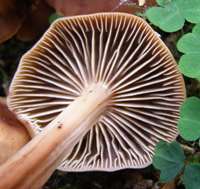 |
Gills
White, tinged tan-brown, developing rusty spots; adnexed or free; very widely spaced.
Stem
White near the apex, tan towards the base; spindle-shaped and usually grooved and sometimes lined longitudinally; 7 to 15cm long and 0.8 to 1.5cm diameter; no stem ring. |
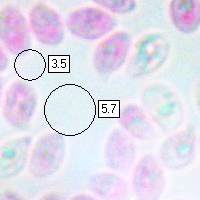 |
Spores
Ellipsoidal to pip-shaped, smooth, thin-walled, 4-6 x 2-3μm; hyaline.
Spore print
White. |
Odour/taste |
Not distinctive. |
Habitat & Ecological role |
Parasitic/saprobic on the basal roots of mainly hardwood trees, especially oaks and less commonly Beech. |
Season |
July to October in Britain and Ireland; several weeks later in southern Europe. |
Similar species |
The distinctive shape of the stem makes it almost impossible to confuse this species with any of the other common woodland mushrooms. |
Culinary Notes
Gymnopus fusipes is recorded as 'edible but not worthwhile' in some field guides, but in any case these mushrooms are too tough to be tempting and are therefore not worth considering as a culinary collectible.
Reference Sources
Fascinated by Fungi, 2nd Edition, Pat O'Reilly 2016, reprinted by Coch-y-bonddu Books in 2022.
Dictionary of the Fungi; Paul M. Kirk, Paul F. Cannon, David W. Minter and J. A. Stalpers; CABI, 2008
Taxonomic history and synonym information on these pages is drawn from many sources but in particular from the British Mycological Society's GB Checklist of Fungi.
Acknowledgements
This page includes pictures kindly contributed by David Kelly.
Top of page...
Fascinated by Fungi. Back by popular demand, Pat O'Reilly's best-selling 450-page hardback book is available now. The latest second edition was republished with a sparkling new cover design in September 2022 by Coch-y-Bonddu Books. Full details and copies are available from the publisher's online bookshop...